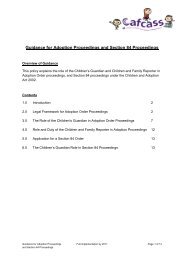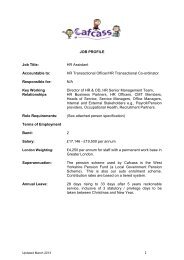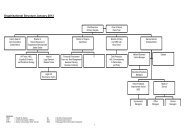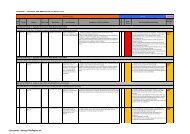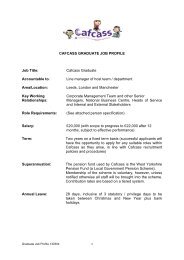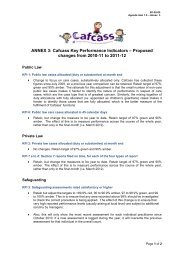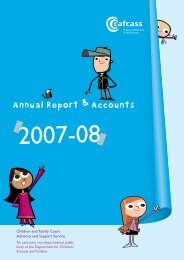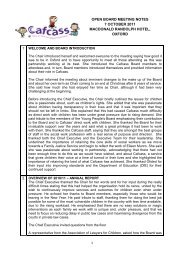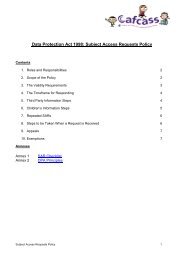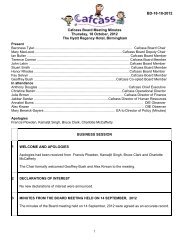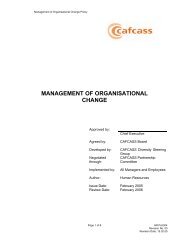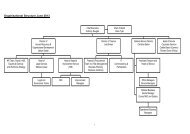Annual Report 2006-2007 - Cafcass
Annual Report 2006-2007 - Cafcass
Annual Report 2006-2007 - Cafcass
You also want an ePaper? Increase the reach of your titles
YUMPU automatically turns print PDFs into web optimized ePapers that Google loves.
Cash Flow Statement for the year ended 31st March <strong>2007</strong><br />
Note <strong>2006</strong>–07<br />
£000<br />
Restated 2005–06<br />
£000<br />
Net cash inflow/(outflow) from operating activities 18a (102,456) (99,393)<br />
Capital expenditure and financial investment 18b (2,531) (489)<br />
Financing 18c 104,373 100,865<br />
(Decrease)/increase in cash (614) 983<br />
The notes on pages 54 to 66 form part of these financial statements.<br />
Notes to the account year ended 31st<br />
March <strong>2007</strong><br />
1 Accounting policies<br />
These financial statements are drawn up in accordance<br />
with the Treasury’s Financial <strong>Report</strong>ing Manual (FReM)<br />
and applicable accounting standards. They are in a form as<br />
directed by the Secretary of State for Education and Skills<br />
with the approval of the Treasury.<br />
The following accounting policies have been applied<br />
consistently in dealing with items considered material in<br />
relation to the accounts.<br />
a) Accounting convention<br />
The accounts are prepared under the historical cost<br />
convention, modified to include fixed assets at their<br />
value to the business by reference to current costs.<br />
Without limiting the information given, the accounts<br />
meet the accounting and disclosure requirements of the<br />
Companies Act 1985 and accounting standards issued<br />
or adopted by the Accounting Standards Board so far as<br />
those requirements are relevant. The accounts are also<br />
consistent, where appropriate, with generally accepted<br />
accounting practice in the United Kingdom (UK GAAP).<br />
b) Going concern<br />
Parliament has voted grant in aid to <strong>Cafcass</strong> for the 12<br />
months following the Balance Sheet date. Therefore,<br />
despite the Balance Sheet position of net liabilities,<br />
<strong>Cafcass</strong> operates as a going concern.<br />
c) Tangible fixed assets<br />
Freehold land and buildings were revalued externally<br />
by the Valuation Office Agency (VOA) as at 1st April <strong>2007</strong><br />
in accordance with the RICS Appraisal and Valuation<br />
Manual, published by the Royal Institution of Chartered<br />
Surveyors, insofar as this is consistent with current<br />
Treasury accounting guidance. Freehold properties are<br />
subject to revaluation by the VOA at least every three years<br />
and by indexation using current cost indices in intervening<br />
years. Leasehold land and buildings and associated<br />
improvements are not subject to revaluation or indexation.<br />
Other tangible fixed assets, except for leasehold property,<br />
have been stated at their value to the business using<br />
appropriate indices published by the Office for National<br />
Statistics. Revaluations above the depreciated historic cost<br />
of an asset are credited to a revaluation reserve. Amounts<br />
equivalent to the depreciation charge on the revaluation<br />
element are then credited to the Income and Expenditure<br />
Account to offset the total depreciation charged on that<br />
asset based on the revalued amount.<br />
Any downward revaluation of fixed assets below the<br />
asset’s depreciated historic cost is offset against any<br />
balance in the revaluation reserve relating to that<br />
particular asset, otherwise it is charged directly to the<br />
Income and Expenditure Account.<br />
Tangible fixed assets include those assets costing £2,500<br />
or more. Individual items valued at less than the threshold<br />
are capitalised if they constitute integral parts of a<br />
composite asset that is in total valued at more than the<br />
threshold. Furniture and fittings are not capitalised but<br />
fully expensed in the year of acquisition.<br />
d) Depreciation<br />
Freehold land is not depreciated.<br />
Depreciation is provided to write-off freehold buildings<br />
and other tangible fixed assets by instalments over their<br />
expected useful lives or, for leased assets, over the life of<br />
the lease.<br />
54 | <strong>Cafcass</strong> <strong>Annual</strong> <strong>Report</strong> and Accounts <strong>2006</strong>–07



